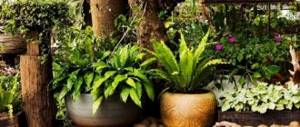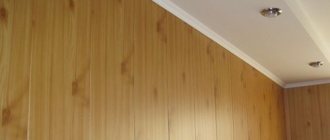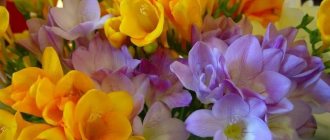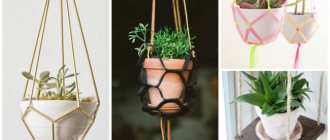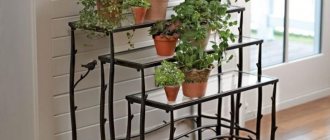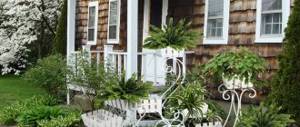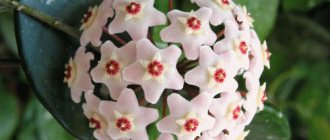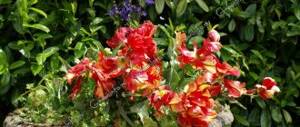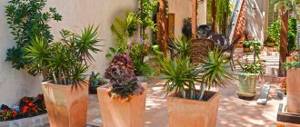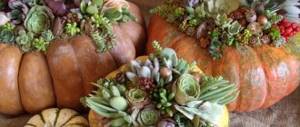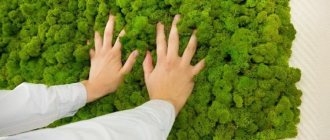Almost every home has flowering plants. They create additional comfort in the room, and also help cleanse and humidify the air space. They delight us with their beauty and lift our spirits.
Beautiful flower pots are very popular; they have long been part of our lives as important details of our interior decor, capable of transforming a space, complementing it with missing color accents.
Choosing the right flower pot is a creative task, the solution of which will highlight the beauty of your indoor plants and provide them with comfortable living conditions.
Let's see what types of flower pots there are. Their assortment is huge in modern stores. What pots are preferable for this or that plant?
Types of pots
The main types are:
- a flower pot
- A flower pot is a container or vessel that can be used to hide the unattractive appearance of flower dishes.
The difference between these flower containers is only the presence or absence of holes at the bottom to allow excess moisture to escape. The flowerpot has no holes to allow water to drain out of it.
Country crafts from flower pots: ideas for the garden
We welcome you, our dear summer residents and summer residents!
Today, in our regular column for those who love handicrafts, we will talk about crafts made from flower pots, household utensils and flowerpots, both new and for various reasons that have fallen into disrepair.
Don’t rush to throw away broken pots; they can turn into very creative things that will definitely have a place in your favorite garden.
When the dishes break for good luck
Let's start, perhaps, with unusable and damaged clay pots. They can be used to create miniature gardens that will decorate with their presence a summer terrace, the foot of an alpine hill, or a picturesque flower garden planted near a country pond.
The larger the pot or flowerpot, the more interesting and painstaking the work. The volume of the composition is achieved through multi-tiered group plantings of textured succulents, various ground cover plants such as saxifrage, alyssum, rosularia, creeping thyme and unpretentious, but very decorative sedum.
Due to their small growth and compactness, these plants are ideal for recreating a wonderful landscape garden in miniature. Ceramic figurines of angels, gnomes and little animals, steep steps leading to a fairy-tale house hidden in the juniper thickets, and many other details will give your garden a fairy-tale mood.
By the way, an old jug with a broken handle can still be very useful, just look at this lovely arrangement of succulents. Along the perimeter of the concrete flowerpot, two types of sedum, contrasting in color, are planted, take, for example, rock sedum and Lydian sedum. At the base of the jug there are succulent rosettes of echeveria spectacularly arranged.
In the absence of this exotic, it can be replaced with more affordable juveniles. From the neck of the jug, like streams of water, pearl threads of Rowley's ragus shoots cascade. The idea is simply amazing!
Cracked flowerpots and clay amphorae can still serve their purpose in transforming your garden landscape. Containers laid on their side and buried a third of the volume will become an attractive accent in a flower garden with a scattering of multi-colored petunias or a picturesque path of field daisies against the backdrop of an emerald lawn.
From broken and out-of-print cups, bowls and teapots, you can build an original mosaic panel for growing succulents, an unusual birdhouse, or play up a theme with a mini-pond. There are a lot of ideas, you just need to make a little effort to give a second life to your country dishes.
Flower pots in a country interior
Potted crops are incredibly popular among gardeners. They are used to decorate window openings, railings on terraces and summer verandas, and are grown in attached containers and as hanging plants. But compositions made from several pots mounted on top of each other using fittings, a la the Leaning Tower of Pisa, look much more interesting.
There is no shame in placing such a floral masterpiece in the middle of a picturesque flower garden or near thickets near a small pond.
Here are some more cute ideas for decorating the entrance area of your home. A spherical composition of pots of various sizes or a traditional “wreath” above the door will certainly appeal to those who are not accustomed to being content with standard solutions.
Large ceramic pots with oval holes on the sides are ideal for creating picturesque multi-tiered compositions using climbing and ground cover plants. If desired, you can quickly build an impromptu coffee table from such a multifunctional pot.
When caring for birds, we should not forget that here, too, flower pots can be used for their intended purpose. A cute birdhouse or bird feeder will help your assistants in catching harmful insects find a permanent residence in your garden.
And finally, a couple more original solutions for arranging summer cottages. An antique chandelier suddenly discovered in the attic can easily turn into a wonderful hanging flower garden.
And a picturesque couple of clay men, sitting at ease in the shade of a hedge covered with ivy, will give a remote corner of the garden coziness and a spiritual mood.
We wish you creative success and inspiration! Share with us your ideas for arranging a garden, and we will be happy to voice them on the pages of our country blog!
Tatyana Soboleva
Size and shape of the pot
When choosing a home for your flower, take care of the combination of beauty and usefulness. If you won't be repotting the plant in the near future, an appropriately sized pot should be a good choice.
As a rule, the size of the pot is a third or a quarter of the height of the plant, and when choosing the shape of the pot, an important factor is taking into account the development of the root system. If you find it difficult to find the ideal option, then pots of a standard shape and size will come to the rescue.
If there is a need to decorate an unattractive container in which a plant sits, or a flower sprout temporarily placed in a plastic container you plan to replant, then you will need a flowerpot. It maintains humidity around the flower and in the room, especially during the heating season.
And during the off-season, when watering, in order not to ruin the roots of the flower, the remaining water must be drained. The planter is suitable for unstable or climbing plants to support balance.
The size of the pot depends on the size of the dishes for which we choose it. The flowerpot should not be much larger than the container with the flower itself.
Types of pots for indoor plants
Today in stores you can see a huge variety of containers designed for planting indoor plants. Each type of flower pot has its own positive and negative characteristics, which every buyer should know about and purchase exactly what is needed for a certain type of plant.
♥ Clay (ceramic) pots for plants are among the most durable tableware options. Their main disadvantage is their considerable price. However, if the budget allows, it is best to decorate the interior with plants in ceramic pots: it is both beautiful and safe from an environmental point of view. Moreover, you can decorate them to your liking.
https://youtu.be/lLtLV6T-6o8
Clay pots differ from other flower containers in that they have a porous structure that allows the plant roots to breathe freely. In addition, through the pores of such a container, excess moisture from the soil evaporates, so flowers in clay containers are less likely to get sick and there is no need to worry about overflowing and rotting. The disadvantage of clay pots is that moisture-loving and heat-loving plants will not feel very comfortable in them. Therefore, clay flower pots should be selected based on the type and variety of flower/plant.
ceramic flower pots are the most durable and environmentally friendly
♥ Plastic flower pots are the cheapest. The choice of colors is very diverse and you can choose any option that will match the color scheme of the room and serve as an original decorative element. Plastic containers are very easy to clean. However, such pots do not allow moisture or air to pass through. Under no circumstances should plants be planted in plastic pots without holes in the bottom, otherwise their roots will soon rot. At the same time, you should not forget about the drainage at the bottom, which you can buy ready-made in the store, or you can add simple washed river sand or pebbles.
plastic flower pots - easy to clean and come in a wide variety of colors
♥ Wooden pots for indoor plants are not found on sale very often, because they are not particularly loved by gardeners. The fact is that wooden containers require careful care; they need to be washed promptly and coated with paint or varnish from time to time. The undeniable advantages of wooden containers are their beauty, originality and ability to pass air.
wooden flower pots will fit perfectly into any interior
♥ Wicker baskets add notes of rural style to the interior, making it closer to nature and lively. But you can’t pour soil directly into such a basket: it will constantly spill out through the cracks between the rods. Therefore, the bottom of wicker pots is covered with plastic film, in which several holes are made for drainage.
wicker flower pots are a great decorative element for decorating a room in a rustic style
♥ Metal pots are not suitable for keeping flowers as they oxidize quickly. But in such a pot you can place a ceramic container with a plant. The metallic “outfit” will allow the green pet to look unusual.
metal flower pots will become a bright and unusual interior detail that will attract attention
Material of manufacture
Pots can be ceramic, glass, metal, or plastic. Each material has positive and negative sides.
Clay pots have not lost their popularity all over the world, although they have been used for many centuries. The ancient Egyptians first began to plant plants in them.
Vessels made from this material are ideal; thanks to their microscopic porosity, they promote the flow of oxygen to the roots, ensure the evaporation of moisture, and have sufficient weight and stability. The downside is the high price of clay products and fragility.
Plastic pots are in fashion today. They are widely popular among florists due to their bright appearance, variety of shapes and sizes, ease of care and low price.
The disadvantages of the material are the greenhouse effect, which promotes the formation of rot and the instability of the pot due to its low weight.
Glass and iron pots are not very popular, as glass is fragile and metal is susceptible to corrosion. Both materials retain moisture and prevent air exchange.
- DIY artificial flowers - the best original home interior design ideas
Volumetric paper flowers - diagrams, templates, decor options and DIY decorations
DIY Roman blinds - instructions for use, installation and combination with interior design
The material of the pots is not significant for the comfort of the plant, and is chosen to your taste. Here the main selection criterion is the design and the place where the flowerpot will be located. There are floor and hanging options for their placement.
Material
Pots can be plastic or ceramic. There is a lot of debate about the pros and cons of both. Let's look at this in more detail.
Plastic pot
Pros : relatively inexpensive price, light weight, easier to clean from dirt and limescale;
Cons : due to its light weight, it can easily tip over, especially if it is small in size; Moisture evaporates only through the top.
Ceramic flower pot
Pros: natural material that promotes sufficient ventilation and thermoregulation (in the summer heat it will optimally protect the plant roots from overheating).
Disadvantages - moisture quickly evaporates through the porous surface, especially near heat sources (heating radiators); Lime deposits may appear on the walls of the ceramic pot, which is very difficult to clean. The best way to remove plaque may be the following: rub the stained areas with potato peels, leave for a while, and then rinse with warm water.
What pots do you use?
PlasticCeramic
Before planting a plant in a ceramic pot, it is recommended to soak the pot in warm water for about a day so that the porous walls are filled with moisture, otherwise the water will be taken from the planting substrate.
Color and decor
When purchasing a pot or flowerpot, the color, shape and elements of its decoration should be combined with the overall decor of the room and be in harmony with the size and brightness of the flower itself.
So, adhering to the basic rules of combining colors or combining elements, it is easy to decorate a house, while emphasizing the beauty of flowering plants. The presented photos of flower pots will help you realize your own creative ideas.
